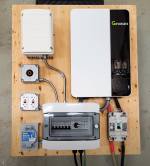Hello All,
I have been following solar installs and tech for off grid for a few years and finally get to build my own system. Pretty hyped But I am not an electrical engineer or veteran diy'er, so I could use any and all help for this project.
But I am not an electrical engineer or veteran diy'er, so I could use any and all help for this project.
My wife and I have a 2022 Cyclone 4006 toy hauler, and would like to take it to private off grid locations so we have a need for both 120v and 240v legs to occasionally support a well pump, mini split, small welder, etc. Not all at once, or even at one location. Weight is not an issue.
I am inclined to build the 'power wall' system by David Poz on youtube:
. Pic attached. The reason I like this is first, it is diy friendly, he explains everything in detail, two, I have the room, three, I can plug in to a 240v circuit.
Base components for solar:
48v Growatt 5kw ES Inverter and autotransformer https://www.signaturesolar.com/products/5kw-es-transformer-kit
(10) 440W 72Split-Cell Silver Mono Solar Panels (I am going to set them on the ground with a kickstand at each off grid location. Have a protective sleeve for each panel and protect them for transport. Plenty of room on the tow vehicle and garage of the toy hauler to store them. I can also reduce the number of panels if to cumbersome, not needed in the summer months, etc. As tech gets better, may mount new and/or better adhesive panels on the roof and switch these to a permanent house situation.)
(4) SOK 100Ah 12V LiFePO4 Deep Cycle Batteries configured 48v (option to upgrade to 8 if needed)
To integrate it into the RV, I am looking at removing the generator leg from the auto transfer switch PD52 (pic attached) and replacing it with the 120v 50a load leg from the power wall. I suppose I should put a manual disconnect/switch here to remove the solar when plugged into shore power. In his build, he has a plug receptacle to attach generator power to support charging the batteries, again I could probably add a manual disconnect/switch? Or is there an automatic switch for shore/gen/solar?
My thought is to use the solar 120v 50a circuit to take the place of the generator input, use the PD52 auto switch for when we plug into shore power, and manually switch to the generator only when the batteries need it.
I am hoping to keep the lead acid 12v system in place, which would have 2 battery systems, one DC and the solar for AC, and use all the 120v AC wiring as is.
Thanks in advance for any advice, tips, or critiques,
Eric
I have been following solar installs and tech for off grid for a few years and finally get to build my own system. Pretty hyped
My wife and I have a 2022 Cyclone 4006 toy hauler, and would like to take it to private off grid locations so we have a need for both 120v and 240v legs to occasionally support a well pump, mini split, small welder, etc. Not all at once, or even at one location. Weight is not an issue.
I am inclined to build the 'power wall' system by David Poz on youtube:
. Pic attached. The reason I like this is first, it is diy friendly, he explains everything in detail, two, I have the room, three, I can plug in to a 240v circuit.
Base components for solar:
48v Growatt 5kw ES Inverter and autotransformer https://www.signaturesolar.com/products/5kw-es-transformer-kit
(10) 440W 72Split-Cell Silver Mono Solar Panels (I am going to set them on the ground with a kickstand at each off grid location. Have a protective sleeve for each panel and protect them for transport. Plenty of room on the tow vehicle and garage of the toy hauler to store them. I can also reduce the number of panels if to cumbersome, not needed in the summer months, etc. As tech gets better, may mount new and/or better adhesive panels on the roof and switch these to a permanent house situation.)
(4) SOK 100Ah 12V LiFePO4 Deep Cycle Batteries configured 48v (option to upgrade to 8 if needed)
To integrate it into the RV, I am looking at removing the generator leg from the auto transfer switch PD52 (pic attached) and replacing it with the 120v 50a load leg from the power wall. I suppose I should put a manual disconnect/switch here to remove the solar when plugged into shore power. In his build, he has a plug receptacle to attach generator power to support charging the batteries, again I could probably add a manual disconnect/switch? Or is there an automatic switch for shore/gen/solar?
My thought is to use the solar 120v 50a circuit to take the place of the generator input, use the PD52 auto switch for when we plug into shore power, and manually switch to the generator only when the batteries need it.
I am hoping to keep the lead acid 12v system in place, which would have 2 battery systems, one DC and the solar for AC, and use all the 120v AC wiring as is.
Thanks in advance for any advice, tips, or critiques,
Eric


